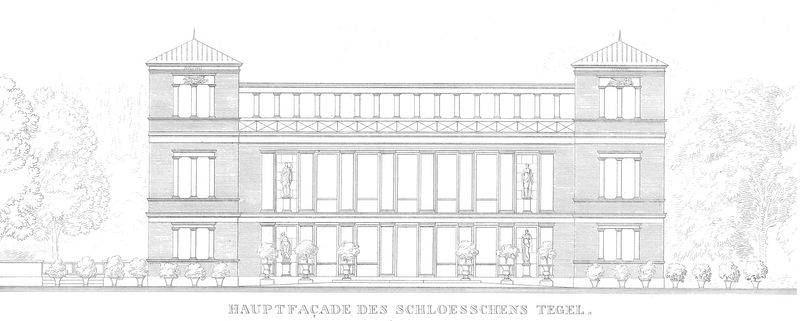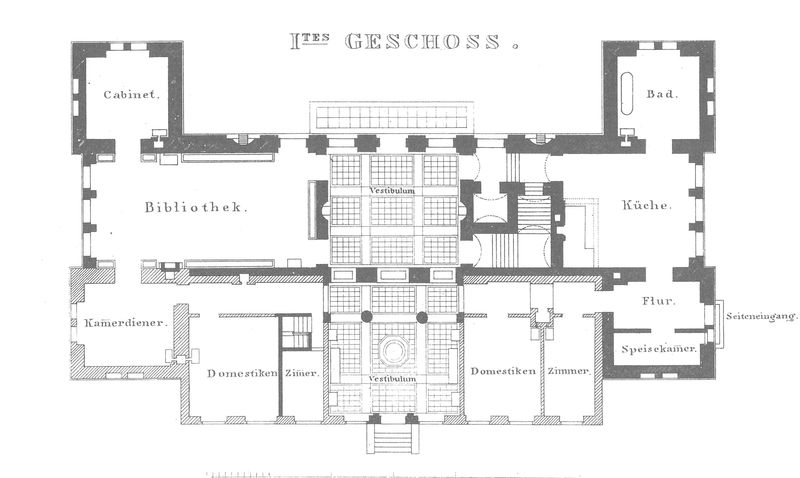Martina AbriSchloss Tegel: The Story of a Total Work of Neoclassical Art for Wilhelm von Humboldt
Both the interiors and the exteriors of two of Karl Friedrich Schinkel’s buildings in Berlin, the Friedrichswerdersche Church and Schloss Tegel (Castle Tegel), have survived in their original state. While the Friedrichswerdersche Church, Schinkel‘s first imposing brick building, was damaged during foundation work on the neighboring property and has not been accessible for several years, Tegel Castle, situated on the northern periphery of Berlin, still belongs to the direct descendants of Wilhelm and Caroline von Humboldt 1 and is in use. Due to the care of generations of owners, this ensemble of historical buildings has survived unchanged. (Fig.1)
From 1822 to 1826, Schinkel renovated what was originally a Renaissance-era estate. The work was done in accordance with the wishes of the owners, Wilhelm and Caroline von Humboldt, who were closely consulted. A friend, sculptor Christian Daniel Rauch, was also involved in the remodeling, since some elements of the castle—the so-called Blue Salon and the Antikensaal (Antiquities Gallery) with its Kabinetten (cabinet rooms)—would also be used as a museum for the many antiquities from Italy as well as statues by contemporaneous artists. (Fig. 6)
Taking the previous building’s design into consideration, Schinkel created a neo-classical ensemble with four towers. The old Renaissance building can still be recognized in the east façade. Schinkel also included exemplary elements of the old hunting lodge, a side tower, and two semi-circular bowfronts. (Fig. 2) Around 1777, Wilhelm’s father, Alexander Georg von Humboldt, commissioned the family’s tutor, Gottlob Johann Christian Kunth, to connect the house to the park and in 1829, a family tomb, designed by Karl Friedrich Schinkel, was incorporated after the death of Caroline von Humboldt. The burial site is visible from the castle, situated on the edge of a wood, embedded inside a kind of hippodrome. An exedra—a permanent outdoor bench—borders the site, while an Ionian column bears a sculpture of Spes, the Roman goddess of hope, by Bertal Thorvaldsen. The Spes was Caroline von Humboldt’s favorite statue, and her friend Friedrich Tieck provided a copy for the tomb.
The building’s design, as well as the entire concept for the interior, are the result of an intense collaboration between the property owners and the architect—a fortunate consequence of their close interpersonal relationship. The interior contained antique and modern works of art, brought back by the Humboldts after their sojourns to Paris, Rome, and Vienna. The façades for the corner towers were finished with reliefs of the so-called eight winds, crafted by Christian Daniel Rauch after the original Tower of the Winds in Athens. (Fig. 3) In 1815 Wilhelm von Humboldt went to the Louvre to study the ancient statuary brought back by Napoleon from his Italian campaign. In consultation with Caroline, he selected copies of the Minerva Giustiniani, the wounded Amazon from the Capitoline Museum, and Praxiteles’s Diana of Gabii and Fawn to ornament the niches in the western façade. In 1834, Christian Daniel Rauch went to Carrara to carry out the commission, and just two years later, under Schinkel’s supervision, the statues were placed in the four niches of the garden façade.
Judiciously, Schinkel began the task of remodeling. He described his plans as follows:
Therefore, there must be a wish that the new building—made necessary by the dilapidated state of the old one—be carried out in a style that would have the same effect upon the picturesqueness of the area, while at the same time retaining the character of a small castle, which has long made the old building of general interest. The desire to preserve a part of this old building, to which some good memories of the estate are attached, and which has a solid foundation with vaulted cellars, especially contributed to giving the new building this particular form.2
Although the castle’s interior is a synthesis of re-designed Renaissance and modern neo-classicism, the building was created in the spirit of the Enlightenment. The clever combination and staging of the room sequences are complemented by the rich décor of marble sculptures and plaster casts. From 1802 to 1806, Wilhelm von Humboldt, appointed by Friedrich Wilhelm III, represented the Prussian government at the papal seat in Rome. At the Humboldts’ imposing home in the Palazzo Tomati, near the Spanish Steps, Caroline held a salon where all of the prominent political personages she supported and the artists she promoted and acquired work from, met—including Gottlieb Schick, Christian Friedrich Tieck, Wilhelm von Schadow, and Karl Wilhelm Wach. Angelika Kauffmann and Ludwig I of Bavaria visited their home and she was close friends with the sculptor Christian Daniel Rauch and the Danish sculptor Bertel Thorvaldsen, who made many of the reliefs and statues that adorn Tegel Castle.
Depending upon the significance and function of the various interior spaces, the rooms were done in a variety of colors and techniques. Schinkel also designed all of the furnishings, including the lamps, tables, chairs, and sofas for the living area, as well as the pedestals, steles, and bases for showing the art. Schinkel established the organization and arrangements together with Wilhelm and Caroline von Humboldt.
The vestibule, together with the garden room, makes up the atrium, and it is here that one can see the combination of the Renaissance and new buildings. (Fig. 4 and 5) The walls were painted to resemble ashlar, while the ceiling was painted to look like a coffered ceiling with stars, framed by an egg-and-dart design. The floor was patterned in marble and terra cotta tiles while Thorvaldsen’s reliefs were set into the walls. In the middle of the atrium—the transition from old to new—were Doric columns, supporting the old external wall. An ancient fountain on a pedestal sets an accent, ornamented with Bacchic reliefs which used to be in the church of St. Calisto in Trastevere, Rome: the fountain of Callixtus. According to legend, St. Callixtus was said to have been drowned in this marble fountain, and the water taken from it was thought to be miraculous. From the atrium, there is a garden view, looking toward the hippodrome and Thorvaldsen’s statue of Spes. (Fig. 5)
From there, the adjacent room is Wilhelm von Humboldt’s study and library, where the walls are painted in green and framed by borders. Schinkel used plank flooring, with two adjacent frames bordering the planks, creating the impression that the space is divided in two. The corners of the frames are mitered. Here, the doubling of the spatial structure is clearly legible as the doubling of the elements, coupled with the floor pattern, emphasizes the symmetry of the space.
Although relatively narrow, the staircase that leads from the garden room to the second floor has a sense of openness and generous space, thanks to vaulting and wall niches here and there. Pompeiian paintings on paper accompany anyone going up the stairs. Ultimately, visitors enter the Blue Salon, with an angled corridor leading to the dining room. (Fig. 6) A more private space, the dining room is connected to the kitchen by a small dumbwaiter, a somewhat common piece of equipment for the period. The other, more public spaces on the second floor such as the Blue Salon, the Antiquities Gallery with its blue and green cabinets along with the dining room, all feature panel parquet flooring.
The Blue Salon is the reception room on the upper floor. The arrangement of the furniture and objets d’art—many of them paintings and sculptures of family members—creates an elegant atmosphere. From the center axis of the salon, one comes to the Antiquities Gallery, with its cabinets: one on the west side, done in blue, and the other on the east side, done in green. (Fig. 6)
During the construction phase, the arrangement of the antiques and contemporary art was firmly established with the assistance of Christian Daniel Rauch. The valuable gifts from Pope Pius VII were thus suitably presented. Statues are placed on pedestals in front of the walls painted to resemble marble. Bas reliefs adorn the upper third of the walls. To facilitate this installation, Schinkel designed wooden pedestals with revolving plinths so that the sculptures could be seen from all sides.
In 1993 a poorly installed roof drainage system caused a great deal of water damage to the flat roof (fig. 7) so that nearly all of the original coffered ceiling painting was lost. The pigments for the imitation marble on the walls were washed away, and Thorvaldsen’s plaster reliefs were covered in dirty watermarks. Not only was part of the west wall destroyed, but the north wall also showed evidence of water damage. Based on detailed documentation of the damage, a plan to restore the walls and ceiling was worked out.
The remains of the ceiling mural were preserved and masked with Japanese paper. The coffered ceiling mural, with its stars and egg-and-dart patterns, was reconstructed by hand on this surface. One of the original surviving lacunars is now part of the new version. Prior to execution, external testing was carried out on the hot-glue method used for the overcoating. So-called tratteggio retouching was used for the walls, meaning that the problem spots were adjusted with tiny brushstrokes and dots. Upon close inspection, the original substance and the new additions can be clearly distinguished.
The panel parquet floor in the Antiquities Gallery was done with particular care. A wooden frieze circling the room provides the finishing touch between the floor and the wall. The corners of the friezes run straight into each other—only around the fireplace set into the east wall of the Antiquities Gallery are the corners unconnected.
The wonderful, harmonious color scheme of the Antiquities Gallery was brought to life again when the floors, colors, and surface textures were restored. (Figs. 8 and 9) To aid in the restoration work on the walls and ceiling in the Antiquities Gallery, pedestals were moved from their positions along the periphery to the center. Likely, the pedestals had not been moved since they were first placed there, and their removal revealed the sealed panel parquet floor from the Schinkel era. The original hue of the wax layer on the panel parquet floor was exposed, an important building block in understanding Schinkel’s color concept for the various shades of green in the trompe l’oeil marble walls and the coffered ceiling murals, with gold stars on a blue background, were originally supplemented by the honey-yellow, matte-gloss panel parquet, shimmering slightly gold in the light.

Figure 1.0 Perspective of the castle. From K.F. Schinkel, Sammlung Architektonischer Entwürfe, Berlin 1866, plate 25.

Figure 2.0 The north façade. From K.F. Schinkel, Sammlung Architektonischer Entwürfe, Berlin 1866, plate 26.

Figure 3.0 The west façade (the garden side). From K.F. Schinkel, Sammlung Architektonischer Entwürfe, Berlin 1866, plate 26.

Figure 4.0 View of the vestibule. From K.F. Schinkel, Sammlung Architektonischer Entwürfe, Berlin 1866, plate 26.

Figure 5.0 Ground floor plan. From K.F. Schinkel, Sammlung Architektonischer Entwürfe, Berlin 1866, plate 25.

Figure 6.0 Second floor plan with Hall of Antiquities, the blue and green cabinets, and the Blue Salon. From K.F. Schinkel, Sammlung Architektonischer Entwürfe, Berlin 1866, plate 25.

Figure 7.0 Third floor plan with private rooms. From K.F. Schinkel, Sammlung Architektonischer Entwürfe, Berlin 1866, plate 25.

Figure 8.0 Survey photograph of the north wall. Antiquities Gallery, Tegel Castle, Berlin, 2003.

Figure 9.0 Survey photograph of the west wall. Antiquities Gallery, Tegel Castle, Berlin, 2003.
Bibliography
Rave, Paul Ortwin. Wilhelm von Humboldt und das Schloss zu Tegel. Leipzig 1950.
Kania, Hans and Möller, Hans-Herbert. Schinkel-Lebenswerk, Mark Brandenburg. Berlin 1960.
Schinkel, Karl Friedrich. K.F. Schinkel, Sammlung Architektonischer Entwürfe. Berlin 1866.
Von Heinz, Christine and Ulrich. Wilhelm von Humboldt in Tegel, Ein Bildprogramm als Bildungsprogramm. Munich, Berlin 2018.
-
Friedrich Wilhelm Christian Karl Ferdinand von Humboldt (1767–1835) was a Prussian philosopher, linguist, diplomat, founder of the Humboldt University of Berlin and husband to Caroline von Humboldt, née Carolina Friederica von Dacheröden (1766–1829), a salonnière and art historian.
↩ -
K.F. Schinkel, Sammlung Architektonischer Entwürfe, Berlin 1866, plates 25, 26; p. 3
↩